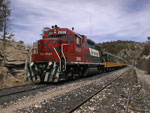Home » Mexico Destinations » Copper Canyon » Copper Canyon Attractions
Copper Canyon Attractions
Basaseachic Falls
One of the Copper Canyon's and Chihuahua's most famous sites is Basaseachic Falls within Basaseachic National Park, which covers a spectacular part of Candameña Canyon The Basaeachic Cascade is the second highest waterfall in Mexico and the 28th in the world, its beauty is extraordinary and is blanketed by one of the best-preserved pine forests of the range.
Canyons of the Copper Canyon System
Copper Canyon (Barranca del Cobre) is a region in Northwest Mexico providing some of the most spectacular scenery in all of Mexico. The Copper Canyon area is a series of 20 canyons, formed over the years by six rivers. Mexico established the Parque Nacional Barranca del Cobre (Copper Canyon National Park) to showcase this remote area. The canyon is the traditional home of the indigenous Raramuri (Tarahumara) people. The Copper Canyon is a UNESCO World Heritage Site.

The Chihuahua al PacÃfico Railroad - El Chepe
The Chp (Chihuahua al Pacifico, or El Chepe) was privatized in 1998 being taken over by the private rail franchise Ferromex. The CHP is a major rail line in northwest Mexico, linking the city of Chihuahua, Chihuahua, to the town of Los Mochis, Sinaloa, near the Pacific coast. It runs 650 km (400 miles), traversing the Copper Canyon, a beautiful and rugged series of canyons that have led some to call this the most scenic railroad trip on the continent.
Copper Canyon Area Cities
Copper Canyon (Barranca del Cobre) is a region in Northwest Mexico providing some of the most spectacular scenery in all of Mexico. The CHP is a major rail line in northwest Mexico, linking the city of Chihuahua, Chihuahua, to the town of Los Mochis, Sinaloa, near the Pacific coast. Along the tour the trains stops in several cities all with unique attractions. Explore the cities of Los Mochis, Creel, El Fuerte and many others...
Cusarare Falls
Located 14 miles (22 kms.) south of Creel along the Creel to Guachochi road, is Cusarare Falls. 'Cusarare' meaning 'Place of the Eagles' to the Raramuri, is an apt name for this small, side canyon that abuts the much larger canyon system, Cusarare Falls is one of the most popular destinations for visitors to the Sierra Tarahumara. Cusarare Falls drops 100 feet (30 meters) to join the Urique River in the Copper Canyon. This area is surrounded by a pine forest. Nearby is Recowata hot springs.
Pea del Gigante - Balancing Rock
This stone monolith stands out on a national and international level for having a totally vertical face and its sheer magnitude, with a free fall of 885 meters (2,290 feet). Pea del gigante has now become recognized for its climbing potential.
Piedra Volada
With a free fall of 453 meters, Flying Stone Falls is considered the highest in Mexico and the 11th highest in the world. Although its flow is not as great as that of Basaseachic, the cascade does flow during the rainy season in mid-summer, early fall. It is located in an isolated area. The magnificent paths that lead to Piedra Volada offer some great viewpoints including Huajumar and Cerro de la Corona.
Recowata Hot Springs
Just 13 miles (22 km) from Creel you can hike up to Cusarare falls then continuing to Recowata hot springs. This very popular hot springs sits at the bottom of a small canyon called Tararecua and can be reached by car, bicycle, horseback or even on foot. The spring itself is a scalding 145F (127C); but it drains into the river and cools, providing a soothing transitional area of warm water. There are also ancient cave paintings on the path to the falls that you don't want to miss.
Tarahumara Indians - Raramuri
The Tarahumara Indians of northern Mexico's Sierra Madre are among the largest and most traditional native American societies in all of North America. There doesn't appear to be a consensus regarding the number of Tarahumara Indians living in the Sierra Madre but estimates range from 35,000 to 70,000. They are currently confronted by the rapid loss of their language and cultural traditions and severe degradation of their environment
Back To Top